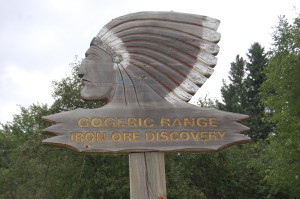
Michigan Roadside Attractions: 1st Avenue Railroad Overpass and Gogebic Range Iron Ore Discovery Site in Bessemer
While on our way through Bessemer to check out a small waterfall on our recent trip to the Upper Peninsula, we passed by two interesting roadside attractions just a mile south of US-2. The 1st Avenue Railroad Overpass bridge has a design that survives in only one other part of the state, and a small parklet just south of the bridge commemorates the location where the first iron ore discovery of the Gogebic Range was made.
The railroad bridge is one of only two in the state (the other is in Detroit) to utilize a truss structure over highway grade separations. It is 195 feet long and 8 feet wide, and was constructed in 1896. No longer open to rail traffic, it is supported by a wooden substructure and features several different design components all mixed together. Its primitive and weathered look makes it stand out today, turning attention back to a busier time when mining dominated this part of Gogebic County.
A little further south on Spring St. we found a small cleared area with the familiar Gogebic County historic site sign (a wooden Indian head). A few small stones flank a monument with a plaque attached to it so we stopped and got a closer look at the plaque, which notes that this is the “site of Colby Mine, 100 feet east, where Richard Langford discovered iron ore in Gogebic County about 1880.”
Both of these sites seem to have been largely forgotten, which is a shame given their historical importance. If you’re in the area to check out the waterfalls on the Black River – Rainbow Falls, Sandstone Falls, Great Conglomerate Falls, Gorge Falls, Potawatomi Falls and Gabbro Falls – consider stopping by the bridge and this park. From US-2, turn south on Moore St. and follow it for about five blocks, then take a right on 1st St. You’ll see the bridge as 1st St. curves and turns to Spring St. and the Iron Ore discovery site is about a quarter mile south on Spring St.









